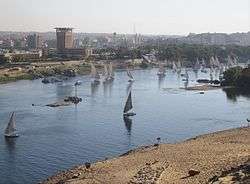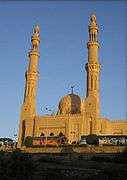Aswan
| Aswan | |
|---|---|
|
River Nile in Aswan | |
 Aswan Location in Egypt | |
| Coordinates: 24°05′20″N 32°53′59″E / 24.08889°N 32.89972°E | |
| Country |
|
| Governorate | Aswan |
| Elevation | 194 m (636 ft) |
| Population (2012) | |
| • Total | 290,327 |
| Time zone | EST (UTC+2) |
| Area code(s) | (+20) 97 |
Aswan (English pronunciation: /ˌæsˈwɑːn/; Egyptian Arabic: أسوان Aswān [ʔɑsˈwɑːn]; Ancient Egyptian: Swenett; Coptic: ⲥⲟⲩⲁⲛ Souan; Ancient Greek: Συήνη Syene), formerly spelled Assuan, is a city in the south of Egypt, the capital of the Aswan Governorate.
Aswan is a busy market and tourist centre located just north of the Aswan Dams on the east bank of the Nile at the first cataract. The modern city has expanded and includes the formerly separate community on the island of Elephantine.
History
| ||||
| swnt.t in hieroglyphs |
|---|
Aswan is the ancient city of Swenett, which in antiquity was the frontier town of Ancient Egypt facing the south. Swenett is supposed to have derived its name from an Egyptian goddess with the same name.[1] This goddess later was identified as Eileithyia by the Greeks and Lucina by the Romans during their occupation of Ancient Egypt because of the similar association of their goddesses with childbirth, and of which the import is "the opener". The ancient name of the city also is said to be derived from the Egyptian symbol for trade,[2] or market.[3]
Because the Ancient Egyptians oriented toward the origin of the life-giving waters of the Nile in the south, Swenett was the first town in the country, and Egypt always was conceived to "open" or begin at Swenett.[1] The city stood upon a peninsula on the right (east) bank of the Nile, immediately below (and north of) the first cataract of the flowing waters, which extend to it from Philae. Navigation to the delta was possible from this location without encountering a barrier.
The stone quarries of ancient Egypt located here were celebrated for their stone, and especially for the granitic rock called Syenite. They furnished the colossal statues, obelisks, and monolithal shrines that are found throughout Egypt, including the pyramids; and the traces of the quarrymen who wrought in these 3,000 years ago are still visible in the native rock. They lie on either bank of the Nile, and a road, 6.5 kilometres (4.0 mi) in length, was cut beside them from Syene to Philae.
Swenett was equally important as a military station as that of a place of traffic. Under every dynasty it was a garrison town; and here tolls and customs were levied on all boats passing southwards and northwards. Around AD 330, the legion stationed here received a bishop from Alexandria; this later became the Coptic Diocese of Syene.[4] The city is mentioned by numerous ancient writers, including Herodotus,[5] Strabo,[6] Stephanus of Byzantium,[7] Ptolemy,[8] Pliny the Elder,[9] Vitruvius,[10] and it appears on the Antonine Itinerary.[11] It also is mentioned in the Book of Ezekiel and the Book of Isaiah.[12]

The latitude of the city that would become Aswan – located at 24° 5′ 23″ – was an object of great interest to the ancient geographers. They believed that it was seated immediately under the tropic, and that on the day of the summer solstice, a vertical staff cast no shadow. They noted that the sun's disc was reflected in a well at noon. This statement is only approximately correct; at the summer solstice, the shadow was only 1/400th of the staff, and so could scarcely be discerned, and the northern limb of the Sun's disc would be nearly vertical. However, Eratosthenes used this information together with measurements of the shadow length on the solstice at Alexandria to perform the first known calculation of the circumference of the Earth.
The Nile is nearly 650 m (0.40 mi) wide above Aswan. From this frontier town to the northern extremity of Egypt, the river flows for more than 1,200 kilometres (750 mi) without bar or cataract. The voyage from Aswan to Alexandria usually took 21 to 28 days in favourable weather.
Climate
Aswan has a hot desert climate (Köppen climate classification BWh) typical of Upper Egypt, in the eastern part of the Sahara Desert, the world's largest hot desert. Aswan is located in one of the sunniest and driest regions on Earth, and thus gets an extremely arid climate. The average rainfall amount barely reaches 0.5 mm/year[13] and periods of several decades have passed without real rain.[14] However, due to the exceptional heavy rainfall event that hit the Egyptian Desert on early March 2014,[15] the average rainfall has increased a bit. Aswan is also exceptionally free of clouds as the mean annual cloud cover is 0.5 tenth[14][16] and completely blue skies are common on most days throughout the year, but especially during summer.[17] The area receives over 4,000 h/year of bright sunshine.[18] Aswan is a hot place, the annual daily mean temperature being 27.3 °C (81.1 °F) with long, torrid summers with daytime temperatures soaring to 45 °C (113 °F) and sometimes over 50 °C (122 °F) and short, very warm winters with more temperate weather as the mercury reaches almost 25 °C (77 °F) during the day but usually falls to 10 °C (50 °F) at night. Aswan is also renowned for its delightful winter climate:[19] perpertual sunny and dry weather, moderately hot days and cool nights, though the heat can already be great in February, especially when hot, dessicating winds come from the southern desert (khamsin) blow over the area during spring.
| Climate data for Aswan, Egypt (2000 - 2016) | |||||||||||||
|---|---|---|---|---|---|---|---|---|---|---|---|---|---|
| Month | Jan | Feb | Mar | Apr | May | Jun | Jul | Aug | Sep | Oct | Nov | Dec | Year |
| Average high °C (°F) | 23.5 (74.3) |
26.4 (79.5) |
30.9 (87.6) |
35.7 (96.3) |
39.4 (102.9) |
41.6 (106.9) |
42.2 (108) |
42.2 (108) |
40.1 (104.2) |
36.4 (97.5) |
29.9 (85.8) |
24.9 (76.8) |
34.43 (93.98) |
| Daily mean °C (°F) | 16.9 (62.4) |
19.2 (66.6) |
23.3 (73.9) |
28.0 (82.4) |
31.9 (89.4) |
34.1 (93.4) |
35.1 (95.2) |
35.1 (95.2) |
32.9 (91.2) |
29.4 (84.9) |
23.0 (73.4) |
18.3 (64.9) |
27.27 (81.08) |
| Average low °C (°F) | 10.2 (50.4) |
12.2 (54) |
15.6 (60.1) |
20.2 (68.4) |
24.4 (75.9) |
26.6 (79.9) |
28.0 (82.4) |
28.1 (82.6) |
25.7 (78.3) |
22.3 (72.1) |
16.2 (61.2) |
11.7 (53.1) |
20.1 (68.2) |
| Average rainfall mm (inches) | 0.2 (0.008) |
0 (0) |
1.0 (0.039) |
0.6 (0.024) |
0.2 (0.008) |
0 (0) |
0 (0) |
0 (0) |
0 (0) |
0.2 (0.008) |
0 (0) |
0.1 (0.004) |
2.3 (0.091) |
| Average rainy days (≥ 0.01 mm) | 0.1 | 0.0 | 0.1 | 0.2 | 0.2 | 0.0 | 0.0 | 0.0 | 0.1 | 0.1 | 0.0 | 0.1 | 0.9 |
| Source #1: Infoclimat [20] | |||||||||||||
| Source #2: Global climatology for Asswan, Egypt (2000 - 2016),[21] | |||||||||||||
Education
In 1999, South Valley University was inaugurated and it has three branches; Aswan, Qena and Hurghada. The university grew steadily and now it is firmly established as a major institution of higher education in Upper Egypt. Aswan branch of Assiut University began in 1973 with the Faculty of Education and in 1975 the Faculty of Science was opened. Aswan branch has five faculties namely; Science, Education, Engineering, Arts, Social Works and Institute of Energy. The Faculty of Science in Aswan has six departments. Each department has one educational programme: Chemistry, Geology, Physics and Zoology. Except Botany Department, which has three educational programmes: Botany, Environmental Sciences and Microbiology; and Mathematics Department, which has two educational programmes: Mathematics and Computer Science. The Faculty of Science awards the following degrees: Bachelor of Science in nine educational programmes, Higher Diploma, Master of Science and Philosophy Doctor of Science. Over 100 academic staff members are employed in.
Transport
Aswan is served by the Aswan International Airport. Train and bus service is also available. Taxi and rickshaw are used for transport here.
Gallery
-
Archangel Michael's Coptic Orthodox Cathedral, built in the Coptic style
-

The El-Tabia Mosque in Aswan
-

A view along the street connecting railway station and Nile
-

A street parallel to Corniche in Aswan
-

The Lotus-Tower near Aswan
-

Aswan
-

The Nile near Aswan
-

Nubia Museum: entrance
See also
|
References
-
 This article incorporates text from a publication now in the public domain: Smith, William, ed. (1854–1857). "Aswan". Dictionary of Greek and Roman Geography. London: John Murray.
This article incorporates text from a publication now in the public domain: Smith, William, ed. (1854–1857). "Aswan". Dictionary of Greek and Roman Geography. London: John Murray.
- 1 2 Baines, John; Malek, Jaromir (March 1983). Atlas of Ancient Egypt (Cultural Atlas). New York, NY: Facts On File Inc. p. 240. ISBN 9780871963345.
- ↑ Suʻād Māhir (1966). Muhafazat Al Gumhuriya Al Arabiya Al Mutaheda wa Asaraha al baqiah fi al asr al islamim. Majlis al-Aʻlá lil-Shuʼūn al-Islāmīyah.
- ↑ James Henry Breasted (1912). A History of Egypt, from the Earliest Times to the Persian Conquest. Charles Scribner's Sons. p. 7.
- ↑ Dijkstra, J. Harm F. Religious Encounters on the Southern Egyptian Frontier in Late Antiquity (AD 298-642).
- ↑ (ii. 30)
- ↑ (ii. p. 133, xvii. p. 797, seq.)
- ↑ (s. v.)
- ↑ (vii. 5. § 15, viii. 15. § 15)
- ↑ (ii. 73. s. 75, v. 10. s. 11, vi. 29. s. 34)
- ↑ (De architectura, book viii. ch ii. § 6)
- ↑ (p. 164)
- ↑ Ezekiel 29:10, 30:6; Isaiah 49:12
- ↑ https://books.google.fr/books?id=Lv51uMFpm8UC&pg=PA192&lpg=PA192&dq=Aswan+rainfall+0.5+mm&source=bl&ots=NaZP9q5bBk&sig=T8VS_rybkDznh1B1U-I4iQ1G0QY&hl=fr&sa=X&ved=0ahUKEwj3jrXBnPjKAhVLVRoKHZZuA70Q6AEIMTAC#v=onepage&q=Aswan%20rainfall%200.5%20mm&f=false
- 1 2 http://www.climates.com/AFRICA/PDF/ASWAN.pdf
- ↑ http://www.wunderground.com/blog/weatherhistorian/comment.html?entrynum=253
- ↑ http://forums.infoclimat.fr/topic/67917-climats-du-monde/page-50#entry2321249
- ↑ https://www.meteoblue.com/en/weather/forecast/modelclimate/asw%C4%81n_egypt_359792
- ↑ https://books.google.fr/books?id=L_iJAgAAQBAJ&pg=PA185&dq=Aswan+4000+hours+of+sunshine&hl=fr&sa=X&ved=0ahUKEwiku_nbn_jKAhXFvBoKHfaaCYkQ6AEIMTAB#v=onepage&q=Aswan%204000%20hours%20of%20sunshine&f=false
- ↑ https://books.google.fr/books?id=t6YxBgAAQBAJ&pg=PT251&dq=Aswan+winter+weather&hl=fr&sa=X&ved=0ahUKEwjYi9HznfjKAhWHMBoKHTqOB1kQ6AEITjAF#v=onepage&q=Aswan%20winter%20weather&f=false
- ↑ "Asswan Climate Normals 2000 - 2016". Forum Infoclimat. Retrieved January 30, 2015.
- ↑ "Normales et records pour la période 2000-2016 à Asswan". Retrieved August 31, 2012.
External links
| Wikimedia Commons has media related to Aswan. |
| Wikivoyage has a travel guide for Aswan. |
| ||||||
| ||||||||||||||||||||||
|
